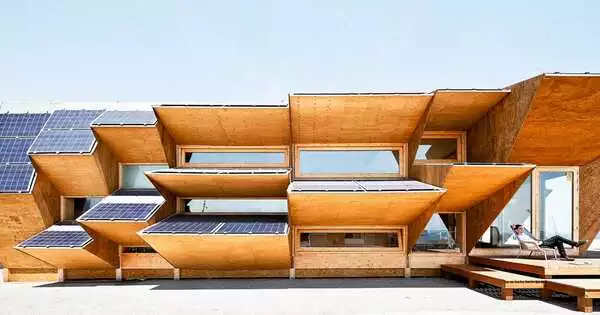Solar architecture is an architectural method that uses the Sun to generate clean, sustainable solar power. It refers to the process of incorporating solar energy and passive solar principles into building and structure design and construction. Solar architecture seeks to maximize the use of solar energy for heating, cooling, and lighting while reducing dependency on nonrenewable energy sources.
This technique is critical for developing sustainable and energy-efficient buildings, as well as lowering carbon emissions and mitigating the effects of climate change. It is related to optics, thermodynamics, electronics, and materials science. Solar architecture requires both active and passive solar dwelling expertise.
The use of flexible thin-film photovoltaic modules allows for seamless integration with steel roofing profiles, increasing the design of the structure. Solar architecture also includes orienting a building to the Sun, selecting materials with favorable thermal mass or light-dispersing qualities, and designing spaces that naturally circulate air.
Here are some key aspects and principles of solar architecture:
- Passive Solar Design: A major aspect of solar architecture is passive solar design. It entails harnessing the sun’s natural movement to heat and cool buildings rather than mechanical systems. Optimizing building orientation, constructing optimal window locations, and harnessing thermal mass to store and transfer heat are all examples of this.
- Solar Gain: The amount of heat collected from the sun through windows and other openings is referred to as solar gain. Depending on the season and environment, properly constructed windows, shading mechanisms, and building materials can optimize or limit solar gain.
- Solar Panels: Solar panels, also known as photovoltaic (PV) systems, can be integrated into building designs to generate power from sunshine. These panels, which may be put on roofs or integrated into building facades, provide a clean and renewable energy source.
- Solar Water Heating: Solar water heating systems use solar collectors to heat water for domestic use or space heating. These systems can be integrated into the building’s design to reduce energy consumption.
- Daylighting: Maximizing natural daylight within a building is a key aspect of solar architecture. Well-placed windows, skylights, and reflective surfaces can reduce the need for artificial lighting, saving energy and improving indoor comfort.
- Shading Devices: To prevent overheating during the summer months, solar architecture often incorporates shading devices such as overhangs, pergolas, and sunshades. These elements help control solar gain and create comfortable indoor environments.
- Thermal Mass: Thermal mass materials, such as concrete or masonry, can store heat and slowly release it, assisting in the regulation of indoor temperatures and reducing the need for heating and cooling systems.
Solar architecture is an interdisciplinary field that blends architectural, engineering, environmental science, and renewable energy principles. It is critical in addressing climate change by lowering the carbon footprint of buildings and promoting sustainable design techniques. As technology progresses and the value of renewable energy grows, solar architecture evolves and adapts to create more energy-efficient and environmentally beneficial structures.












